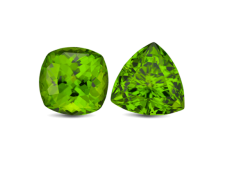The Extraterrestrial Gemstone
 The only known extraterrestrial gemstone is peridot and has been found in pallasite meteorites, which are remnants of our solar system’s birth, 4.5 billion years ago. However extraterrestrial peridot is more likely found in museums than in jewelry stores. London’s Natural History Museum owns peridot crystals in a slice of the esqual pallasite, a meteorite found in Argentina in 1951.
The only known extraterrestrial gemstone is peridot and has been found in pallasite meteorites, which are remnants of our solar system’s birth, 4.5 billion years ago. However extraterrestrial peridot is more likely found in museums than in jewelry stores. London’s Natural History Museum owns peridot crystals in a slice of the esqual pallasite, a meteorite found in Argentina in 1951.
Peridot is more commonly found deep in the Earth’s mantle and brought to the surface by volcanos. Many of the world’s largest peridots were mined by the ancient Egyptians on a small volcanic island in the Red Sea. It has been found in Egyptian jewelry from the early 2nd millennium B.C. and called the “gem of the sun”. The National Museum of Natural History in Washington D.C. houses the Green Goddess, a 311.80-carat peridot mined in Egypt.
Throughout history peridot has been the victim of mistaken identity among green colored gems. Historians speculate that Cleopatra’s famous emerald collection may have been peridot. For centuries, the 200-carat gems adorning the shrine of the Three Holy Kings in Germany’s Cologne Cathedral were believed to be emeralds but are in fact peridot.
The yellow-green color of peridot is caused by traces of iron and the intensity of this unique color is dependent upon the amount of iron present in the gem. Peridot is one of few gems that only come in one color. It is the birthstone for August and the traditional anniversary gift for the 15th wedding anniversary.
Information provided by GIA.

